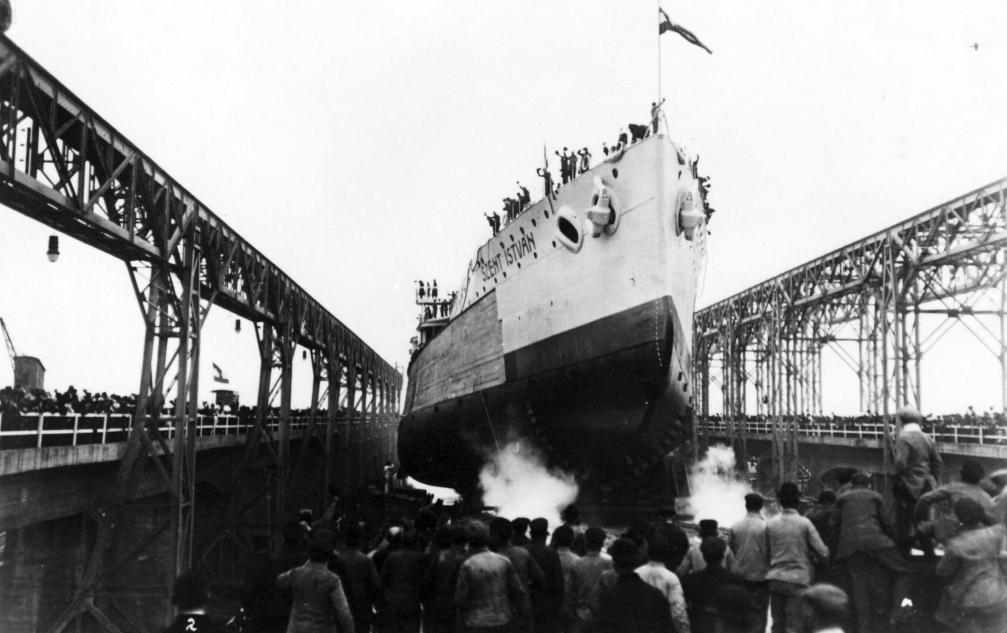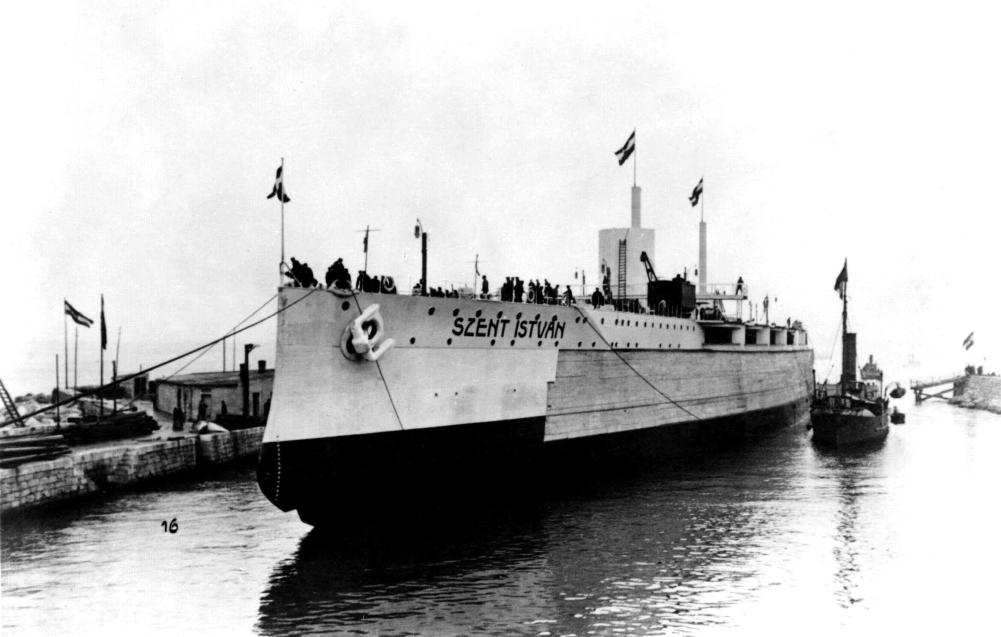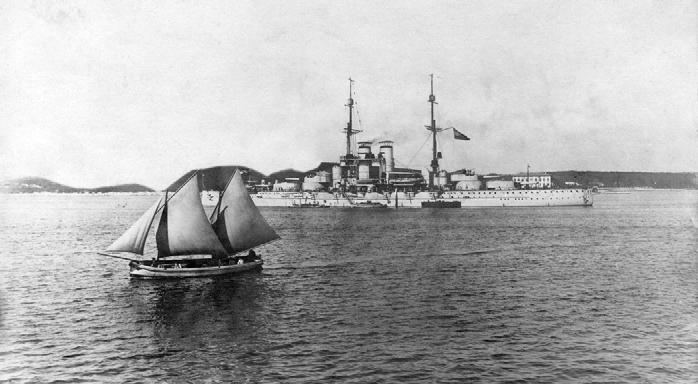
7 minute read
From the Launch to the Commissioning
40 Th e launch of the Szent István on 17 January 1914
happened. All has gone smoothly, only the leg of one man was wounded by the anchor chain.”295
Advertisement
In the evening a party was given at the Governor’s Palace for the illustrious guests. During this event a congratulating telegram from the Emperor arrived which contained the phrase which had been cancelled by Franz Ferdinand from the archduchess’s speech.296 It was a great satisfaction for the Hungarian government and the representatives of the shipyard. Count Tisza asked Maria Th eresia to read aloud the telegram and made publish it in the newspapers. On the order of Fiume’s Governor, István Wickenburg the port was illuminated that evening.
From the Launch to the Commissioning
At the time of her launch the Szent István was in 66 percent complete. In contrast to her sisters, she was launched with bow and stern armor plates on. After the launch she was towed to Pola where she was examined in the great fl oating dock of the Navy between 9 and 17 February. Th ree days after the launch and one day after Pliskovac’s death the Vienna Social Democrat newspaper “Arbeiter Zeitung” criticized the Danubius shipyard in an article titled “Der Blut-Dreadnought” (Th e Bloody Dreadnought) stating that many grave accidents had occurred during the construction thanks to the hunger for profi t of the owners of the shipyard. Th e article accused Manfréd Weisz and his (alleged) greed as being the primary cause of the unconscionably high number of accidents. On the basis of the abovementioned article the Navy made an investigation into the yard that resulted in clearing the Danubius of the accusations of the newspaper. It was concluded that the actual number of the accidents was much less than the alleged number published in the article.297 Th e gravest accident in the Danubius occurred on 26 November 1913 when the 100 ton crane which was under construction collapsed causing the deaths of three workers.298
As mentioned above, because the Navy considered the positioning of the searchlights on the STT built ships less than satisfactory, the searchlight plan of the Szent István was modifi ed. Th is modifi cation added a surplus weight of 54.4 tons to the superstructure high above the waterline.299
— 88 —

41 Szent István after her launch. Note the bow armor plates on and the teak planking as backing for belt armor
Th e MTK later stated that the surplus weight of the searchlight platform did not adversely aff ect the stability of the ship.300
Th e further works on the Szent István were also slow. Th e shipyard itself was fully completed on June 2 1914. On this date, the battleship was in 71.4 percent complete.301 It turned out only after the delivery of the components of the gun turrets that the center pivot’s bases of the aft turrets were 17 cm deeper than on the other ships due to the diff erent propeller shaft arrangement. Th e parts of the bottom of the revolving stalks of the aft turrets had to be reshaped in the shipyard.302
When the war broke out, the Navy ordered on 31 July to tow the ship to the Pola Arsenal in order to better protect the ship and oversee its completion. According the Navy’s plan the building would continue at the Arsenal under the direction of the Danubius and with the yard’s own workers. Th e negotiations between the Navy and the Danubius lasted to January 1915 and the formal agreement was only signed on 25 April 1915. On that day the battleship was in 83 percent complete.303 Th e outfi tting of the four gun turrets was extremely slow the engineer of the Škoda Works who supervised this works complained that every phase of the works lasted twice as long as in the STT.304
Th e outbreak of the war led to the cancellation of the installation of torpedo nets on the Szent István. Th e torpedo nets were imported from Britain and as of August 1914 no more shipments were expected. Th e net booms and the net pieces delivered earlier were stored in the Arsenal as spare parts for the three STT built dreadnoughts. Th e holes which had been already bored for the steel booms of the net were sealed with bolts.305 After the negative German experiences of the war the nets were removed in 1917 from the other units of the class. Th e Szent István had from the start so called “bomb nets”, pieces of old torpedo nets on a metal frame fi tted over the funnel caps whose purpose was to protect the boilers from aerial bombs.
Th e delay of the works became enormous. Th e workers of the Danubius had no interest in fi nishing the construction of the Szent István because after the completion of the battleship the shipyard would dismiss the majority of them and the Army could then conscript the dismissed workers. Th e works on the gun turrets were fi nished in June 1915. In the same month the Arsenal reported that
— 89 —

42 Battleship Szent István. Note the searchlight platform around the funnels and the bomb-nets over the funnel caps. In the foreground a trabaccolo, a typical sailing coaster of the Adriatic it was expected that the ship would be fi nished at the end of 1915.306 Characteristic for the wartime situation the Navy hurriedly fi tted the Szent István with the last available soda water maker because due to the material shortage, especially of copper there was no hope to purchase new soda makers.307 Cold soda water especially in the hot Adriatic summers signifi cantly increased the well-being of the seamen.
Th e fi rst stationary machinery trial of the Szent István began on 14 August 1915. Th e full power trials of the Szent István were executed in the Fasana Channel on 20 and 21 November when her machinery produced 26,400 SHP but her speed oddly enough was not mentioned in the offi cial test report. Th ere are allegations that the ship exceeded 21 knots but there is no evidence that this is true. Others state that the ship allegedly did not reach the design speed of 20 knots.308 However, her machinery performed better than her sister’s. Th e STT built ships were not able to maintain their maximum speed (20.3–20.4 knots) more than two hours, while the Szent István with her heavier and more capable boilers could run at full speed more than eight hours.309 Because of the wartime conditions some trials (for example the 30 hours trial with 17,000 SHP power) were omitted. Th anks to the fewer trials the Navy saved 888 tons of coal.310 While the delivery record was signed on 11 December 1915311 the Navy offi cially commissioned the Szent István on 17 November 1915 under the command of Linienschiff skapitän Edmund Grassberger. Th e Magyar Adria Egyesület presented the bronze plaque of Szent István and a special ensign (díszlobogó) to the ship on 6 January 1916. Th e Adria Egyesület in June 1916 presented four small stained glasses which were fi tted into the four windows of the rear bulkhead of the admiral’s salon two-two on either side of the plaque. During the trials it turned out that at full speed when the ship began to turn with rudder turned to the maximum angle (35 degrees) Szent István listed more than double (19.75 degrees measured by gyroscope) than her sisters and water fl ooded her casemates of the secondary battery because the casemate sealings were not fi tted yet. Due to the sudden list many fell on the bridge and on the deck. Grassberger in his report blamed the high searchlight platform for the extreme list, but the engineers of the MTK stated that the diff erent screw arrangement and the diff erent form of the stern of the ship were the principal reasons of this serious fault. Th e Navy ordered to limit the rudder angle at high speeds to 15 degrees. On the same trial the Szent István produced a list of 8 degrees at full speed with rudder turned to 15 degrees.312









